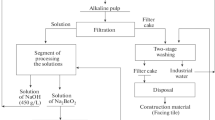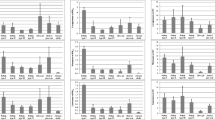Summary
In principle, the determination of Br/Pb- ratios in aerosols opens the possibility to get information on the source of the corresponding emission or on the history of the aerosol. Up to now, different results were obtained in a number of investigations where the Br/Pb-ratio in aerosols was analysed and compared with the same ratio in gasoline. In order to exclude analytical errors during the investigations of this work, the definitive method of isotope dilution mass spectrometry is used to determine the Br/Pb ratios. It could be shown that in aerosols and motorcar exhausts the Br/Pb-ratio is lower than it is given by the additives included in gasoline. In aerosols a Br/Pb-ratio is found in summer time which is lower than in autumn. Additionally, the same is true for aerosols which were collected during rainfalls compared with dry weather. Model experiments have shown that a wrong Br/Pb-ratio can be determined with filters where lead bromide is deposited. Different transportation mechanisms take place for lead and bromine by sucking air mixed with CO2, SO2 or NOx through the filter which leads to a decrease of the Br/Pb ratio. It was also found that bromoorganic compounds which have not been converted into inorganic bromide in the motor can result in a lower Br/Pb-ratio in the inorganic part of the exhaust compared with the composition of gasoline.
Zusammenfassung
Die Bestimmung von Br/Pb-Verhältnissen in Aerosolen eröffnet grundsätzlich die Möglichkeit, auf die Verursacherquelle einer entsprechenden Emission schließen zu können oder eine Aussage über die Vorgeschichte der Aerosole zu erhalten. Im Vergleich zu den Br/ Pb-Verhältnissen im Benzin haben bisherige Untersuchungen von Aerosolen zu sehr unterschiedlichen Ergebnissen geführt. Um bei solchen Untersuchungen Analysenfehler weitgehend auszuschließen, wird im Rahmen dieser Arbeit erstmals die definitive Methode der massenspektrometrischen Isotopenverdünnungstechnik zur Bestimmung der Br/ Pb-Verhältnisse angewandt. Dabei zeigt sich, daß sowohl bei Aerosolen als auch bei Autoabgasen stets ein niedrigeres Br/Pb-Verhältnis gefunden wird, als dies durch die im Benzin enthaltenen Additive vorgegeben ist. In Aerosolen der Luft wird im Sommer ein niedrigeres Br/Pb-Verhältnis gemessen als im Herbst. Gleiches gilt für Aerosolproben, die bei regnerischem im Vergleich zu trockenem Wetter gesammelt werden. Modellversuche zeigen, daß man leicht Fehler in der Br/Pb-Bestimmung dadurch machen kann, daß primär auf Filtern deponierte Blei- und Bromidionen durch die in der Luft vorhandenen Gase CO2, SO2 und NOx in unterschiedlichem Maße wieder vom Filter verflüchtigt werden können, was zu niedrigeren Br/Pb-Verhältnissen führen kann. Weiterhin ergibt sich, daß vom Motor nicht umgesetzte bromorganische Verbindungen offensichtlich bereits für eine Ernie drigung des Br/Pb-Verhältnisses im anorganischen Teil des Abgases gegenüber der Benzinzusammensetzung sorgen.
Similar content being viewed by others
Literatur
Lininger RL, Duce RA, Winchester JW, Matson WR(1966) J Geophys Res 71:2457
Winchester JW, Zoller WH, Duce RA, Benson CS (1967) Atmos Environ 1:105
John W, Kaifer R, Rahn K, Wesolowski JJ (1973) Atmos Environ 7:107
O'Connor BH, Kerrigan GC, Thomas WW, Pearce AT (1977) Atmos Environ 11:635
Kowalczyk GS, Choquette CE, Gordon GE (1978) Atmos Environ 12:1143
Winchester JW, Duce RA (1967) Naturwissenschaften 54:110
Oelschläger H (1978) Dtsch Apoth-Ztg 118:835
Berman E (1980) Toxic metals and their analysis. Heyden, London Philadelphia Rheine, p 118
Jernigan EL, Ray BJ, Duce RA (1971) Atmos Environ 5:881
Martens CS, Wesolowski JJ, Kaifer R, John W (1973) Atmos Environ 7:905
Seiler H, Haas U, Rentschler I, Schreiber H, Wiesner P, Wurster R (1981) Optik 58:145
Countess RJ, Cadle SH, Groblicki PJ, Wolff GT (1981) J Air Pollut Control Ass 31:247
Rhodes JR, Pradzynski AH, Hunter CB, Payne JS, Lindgren JL: (1972) Environ Sci Technol 6:922
Lahmann E, Laskus L: (1979) Staub-Reinh Luft 39:216
Octel Company (1981) Catalogue declaration for the additives TEL-CB and TML-CB
Heumann KG (1982) Int J Mass Spectrom Ion Phys 45:87
Heumann KG, Kastenmayer P, Zeininger H (1981) Fresenius Z Anal Chem 306: 173
Heumann KG, Schindlmeier W (1981) Fresenius Z Anal Chem 306:245
Heumann KG, Kifmann R, Schindlmeier W, Unger M (1981) Int J Environ Anal Chem 10:39
Heumann KG, Schindlmeier W, Zeininger H, Schmidt M (1985) Fresenius Z Anal Chem 320:457
Rentschler W, Schreiber H (1977) Proc 4th Int Clean Air Congress, Tokio, S 562
Pierson WR, Brachaczek WW (1976) Trans Soc Auto Eng 85:209
Iredale T, Macoll A (1937) Nature 140:24
Pierrard JM (1969) Environ Sci Technol 3:48
Harsch DE, Rasmussen RA (1977) Anal Lett 10: 1041
Jonsson A, Berg S (1980) J Chromatogr 190:97
Ballschmiter K, Mayer P (1983) Chemosphere 12:879
Author information
Authors and Affiliations
Additional information
Vortrag anläßlich des Symposiums Anorganische Anionenanalytik, Regensburg, 19.–21. 9. 1984
Der Deutschen Forschungsgemeinschaft sowie dem Fonds der Chemischen Industrie danken wir für die finanzielle Unterstützung.
Rights and permissions
About this article
Cite this article
Baumann, H., Heumann, K.G. Brom/Blei-Verhältnisse in Aerosolen und Autoabgasen. Z. Anal. Chem. 320, 512–518 (1985). https://doi.org/10.1007/BF00479823
Received:
Published:
Issue Date:
DOI: https://doi.org/10.1007/BF00479823




